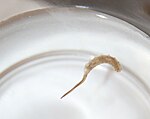Rat-tailed maggot: Difference between revisions
Removed vandalism due to traffic from a digg frontpage. |
Stealthrabbi (talk | contribs) add note about common names |
||
| Line 7: | Line 7: | ||
==Commercial use== |
==Commercial use== |
||
These larvae, commonly called "mousies" are cultured and sold as fish bait. They are especially popular in ice fishing.<ref>[http://www.briancoad.com/Dictionary/M.htm Dictionary of Ichthyology; Brian W. Coad and Don E. McAllister] at ww.briancoad.com</ref> |
These larvae, commonly called "mousies" or "[[Urban Toilet Shrimp]]" are cultured and sold as fish bait. They are especially popular in ice fishing.<ref>[http://www.briancoad.com/Dictionary/M.htm Dictionary of Ichthyology; Brian W. Coad and Don E. McAllister] at ww.briancoad.com</ref> |
||
==Images== |
==Images== |
||
Revision as of 14:23, 18 October 2008
Rat-tailed maggots are the larvae of some species of hoverfly, commonly Eristalis tenax. A characteristic feature of rat-tailed maggots is a tube-like, three segmented, telescoping breathing siphon located at their posterior end.[1] This acts like a snorkel, allowing the larva to breathe air while submerged. The siphon is usually about as long again as the maggot's body (20 mm when mature), but can be extended as long as 150 mm. It is this organ that gives the larva its common name. It lives in stagnant, oxygen-deprived water, with a high organic content. It is fairly tolerant of pollution and can live in sewage lagoons and cesspools.[1]
Infection
There have occasionally been documented cases of human intestinal Myiasis of the Rat-tailed maggot (larvae of Eristalis tenax). Symptoms can be none (asymptomatic) to abdominal pain, nausea and vomiting, or pruritus ani. Infection can be caused by ingestion of contaminated food or water but doubts have been expressed that accidentally ingested fly larvae could survive in the gastrointestinal tract. Zumpt proposed an alternative called "rectal myiasis". Flies, attracted to feces, may deposit their eggs or larvae near or into the anus, and the larvae then penetrate further into the rectum. They can survive feeding on feces at this site, as long as the breathing tube reaches towards the anus.[1][2]
Commercial use
These larvae, commonly called "mousies" or "Urban Toilet Shrimp" are cultured and sold as fish bait. They are especially popular in ice fishing.[3]
Images
-
Eristalis tenax larvae
-
Eristalis tenax larvae
-
"larvae
References
- ^ a b c A. Aguilera, A. Cid, B. J. Regueiro, J. M. Prieto, and M. Noya (1999). "Intestinal Myiasis Caused by Eristalis tenax" (web). Copyright © 1999 American Society for Microbiology {at www.pubmedcentral.nih.gov}. Retrieved 2008-01-13.
{{cite web}}: CS1 maint: multiple names: authors list (link) - ^ Whish-Wilson, Phillip B (2000). "A possible case of intestinal myiasis due to Eristalis tenax" (web). The Medical Journal of Australia. Retrieved 2008-01-13.
- ^ Dictionary of Ichthyology; Brian W. Coad and Don E. McAllister at ww.briancoad.com

